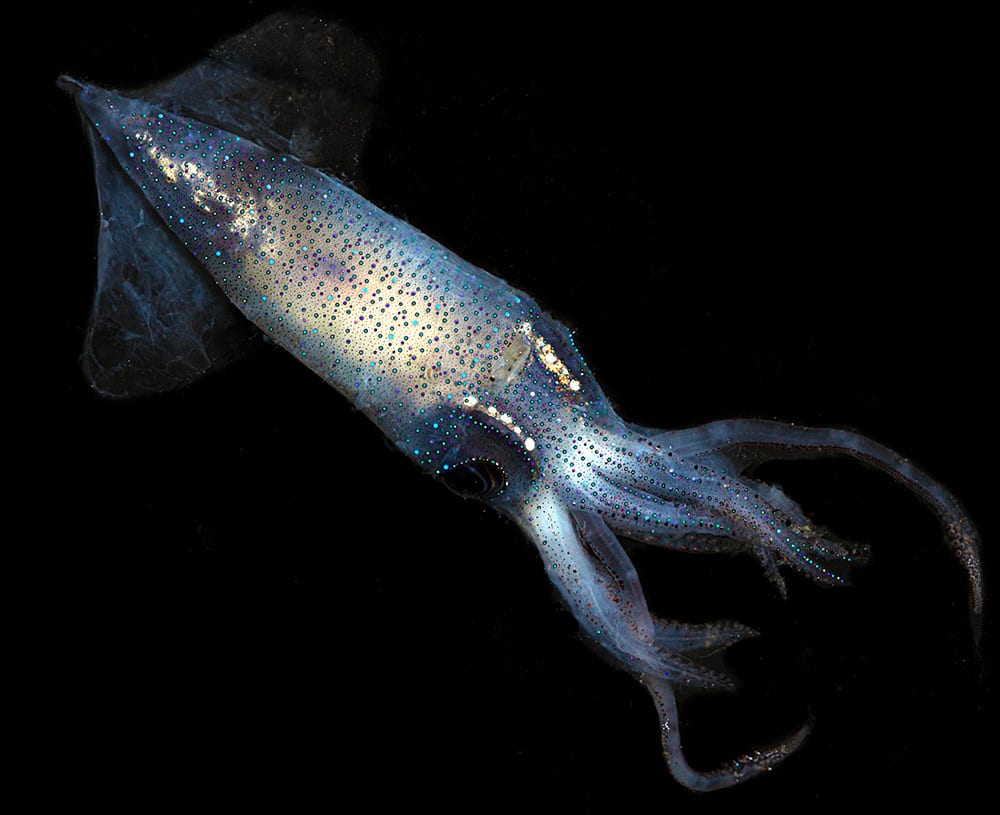A new report from researchers at Woods Hole Oceanographic Institution (WHOI) reveals for the first time the unseen—and somewhat surprising—benefits that people receive from the ocean’s twilight zone. Also known as the “mesopelagic,” this is the ocean layer just beyond the sunlit surface.
The ocean twilight zone is a mysterious place filled with alien-looking creatures. The nightly, massive migration of animals from the zone to the surface waters to find food helps to cycle carbon through the ocean’s depths, down into the deep ocean and even to the seabed, where it can remain sequestered indefinitely.
“We knew that the ocean’s twilight zone played an important role in climate, but we are uncertain about how much carbon it is sequestering, or trapping, annually,” says Porter Hoagland, a WHOI marine policy analyst and lead author of the report. “This massive migration of tiny creatures is happening all over the world, helping to remove an enormous amount of carbon from the atmosphere.”
Exactly how much carbon is difficult to pinpoint because the ocean twilight zone is challenging to get to and is understudied. The WHOI Ocean Twilight Zone project, which launched in April 2018, is focused on changing that with the development of new technologies.
It’s estimated that two to six billion metric tons of carbon are sequestered through the ocean’s twilight zone annually. By comparison, the world’s largest rain forest sucks in only about 544 million metric tons of carbon a year—five percent of the world’s annual 10 billion metric tons of carbon emissions.
Using a range of prices for carbon, reflecting future damages expected as a consequence of a changing climate, this “regulating” service has an estimated value of $300 to $900 billion annually, Hoagland notes. Without the ocean’s ability to sequester carbon, atmospheric carbon dioxide levels could be as much as 200 parts per million higher than they are today (about 415 ppm), which would result in a temperature increase of about six degrees Celsius or 10.8 degrees Fahrenheit.
In addition to its role in the carbon cycle, the twilight zone likely harbors more fish biomass than the rest of the ocean combined, and it is home to the most abundant vertebrate species on the planet— the bristlemouth. While twilight zone fish are unlikely to ever end up on peoples’ dinner plates because of their small size and strange appearance, they do provide meals for larger, economically important fish, like tuna and swordfish, and for other top predators, including sharks, whales, seals, penguins, and seabirds.
The twilight zone’s biological abundance makes it an attractive target for commercial fishing operations. Ocean twilight zone animals could be harvested to produce fish meal to support the rapidly growing aquaculture industry and to provide fish oils for nutraceutical markets. Because the twilight zone is situated largely in unregulated international waters, there is concern that its potential resources could be subject to unsustainable exploitation.
The research team hopes that the report will be useful for decision makers, such as the United Nations delegates who will meet this spring in New York to continue developing a new international agreement governing the conservation and sustainable management of marine life on the high seas, in areas beyond the coastal waters managed by individual member States.
“We need to think carefully about what we stand to gain or lose from future actions that could affect the animals of the twilight zone and their valuable ecosystem services,” says Hoagland. “Increasing scientific understanding is essential if we are going to move toward a goal of the sustainable use of the resources.”
This research is part of the Woods Hole Oceanographic Institution’s Ocean Twilight Zone Project, funded as part of The Audacious Project housed at TED.
The Woods Hole Oceanographic Institution is a private, non-profit organization on Cape Cod, Mass., dedicated to marine research, engineering, and higher education. Established in 1930 on a recommendation from the National Academy of Sciences, its primary mission is to understand the oceans and their interaction with the Earth as a whole, and to communicate a basic understanding of the oceans’ role in the changing global environment. For more information, please visit www.whoi.edu.
News release link: https://www.whoi.edu/press-room/news-release/report-reveals-unseen-human-benefits-from-ocean-twilight-zone/
Direct link to pdf report: http://go.whoi.edu/OTZ-value-report
More imagery available on request.
Original post https://alertarticles.info


